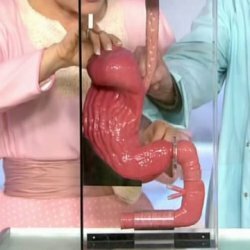Stomach ulcer
 Erosive gastritis and a stomach ulcer is one disease or two different ailments? How to identify them and how to treat them? Further we will understand more in detail.
Erosive gastritis and a stomach ulcer is one disease or two different ailments? How to identify them and how to treat them? Further we will understand more in detail.
Causes of the disease
Gastric ulcer is a lesion of the gastric mucosa. As a rule, it is surrounded by a large area of inflammation. This is a fairly common disease that occurs in 14% of the population around the world.
Occurs, as a rule, when the balance between the factors of aggressive influence and the factors of protection is disturbed.
to protective factors include:
- hydrocarbons, - the epithelial barrier,
- microcirculation,
- gastric mucus,
- hormones( secretin, gastrin, somatostatin),
- prostaglandins,
- active regeneration.
aggression factors are:
- hydrochloric acid,
- pepsin,
- Helicobacter Pylori - Gram-negative spiral bacterium forms infective various stomach.
Risk factors causing peptic ulcer disease are considered:
- Hereditary predisposition
- Smoking
- Alcohol abuse
- Helicobacter Pylori
- Blood Groups( Antigens)
- Medications
- Indigestion
- Frequent stressful condition
- Malnutrition( salty, spicy, coarse food)
- Reduced immunity
- Meteorological effects( seasonality)
- Vitamin deficiency in the body
Ulcers are of four types and depend on localization and degree of onsetzheniya:
- I type - erosive gastritis occurs in the place where the stomach goes in the antrum, as well as in most of the cavity( the body) of the stomach
- II type - associated with ulcerative lesions of duodenal intestine.
- III type - affects the stomach in the part of the pyloric part.
- IV type - ulcers that occur at the junction of the esophagus with the stomach, in the upper part of the stomach itself and at a small curvature. This type of ulcers is strongly prone to malignancy.
Thus, we see that erosive gastritis is one of the types of gastric ulcer.
 Symptoms of gastric ulcer Gastric ulcer any type of patient meet the following symptoms listed above:
Symptoms of gastric ulcer Gastric ulcer any type of patient meet the following symptoms listed above:
- pain in the epigastric region. The nature of the pains burning, pressing, aching, compressive. Pain is also given to the area under the ribs, to the lumbar spine. The duration of pain is different and can range from 1.5 to 3 hours. Characterized by seasonal exacerbations.
- Heartburn Nausea Vomiting
- ( extremely rare)
- white film coated with the patient's language
- palms are always wet
- Promoted sweating;
- anterior abdominal wall is very painful and with pressure on the region responsible epigostralnuyu sharp pang
- Weight loss Constipation
- Belching
- Violation of appetite upward
unbearable pain, it causes a person to bend. The patient covers himself with his hands, squats on his haunches, leans on the edge of the table and so on. N.
Upon detection of these symptoms should seek medical attention.
physician must assign the following diagnostic techniques:
- Blood
- overall analysis of feces reaction Gregersen
- study gastric acid function generator( pH-metry intragastric)
- X-ray of the detection of defects mucosa;
- Fibroezofagogastroduodenoskopiya( FEGDS) with capture of matter from the bottom of ulcers
- Ultrasonography
- biopsy analysis for the presence of Helicobacter pylori
- electrogastrogram
Timely, correct diagnosis of gastric ulcer makes it possible to cure it easily and without special complications. In case of untimely treatment of a specialist, a prolonged illness causes a number of rather terrible complications, such as bleeding, perforation, spreading of ulcers to other organs, perivistseritis, transfusion of the ulcer into malignant formation, peretonit.
Treatment of ulcers
Treatment of gastric ulcer is carried out both in outpatient and inpatient settings.
Indications for hospitalization of the patient can serve as:
- giant stomach ulcer
- detected primary gastric ulcer
- intolerable pain
- concomitant diseases
- exacerbations three to four times a year;
- a severe complication of peptic ulcer
In treatment depending on the indications, form and complexity of the course, both conservative and surgical methods of treatment can be applied.
Conservative treatment includes a complex purpose:
- Substances sorbents and antacids, neutralizing hydrochloric acid
- Cimetidine, Nizatidine, Ranitidine, Famotidine - blocking histamine receptors. Lansoprazole, Omeprazole - ishypytors. All drugs suppress the secretion of gastric juice
- Drugs that help to eliminate the bacterium Helicobacter pylori -( a combination of Clarithromycin, Omeprazole and Amoxicillin taken simultaneously).
- Drugs that enhance the action and manifestation of protective factors( Denol, Sucralfate)
- Spasmolytic
- Sedatives.
Some drugs may have side effects, for example, dry mouth, allergic reactions, headache, leukopenia, diarrhea, gynecomastia.
During the period when the patient is experiencing an exacerbation of peptic ulcer, it is strictly forbidden to take drugs based on salicylic acid or so-called salicylates, antipyretics, analgesics.
Surgical treatment is undesirable and is used exclusively for a number of indications, including: bleeding, perforation, gastrinoma, stenosis and endocrine origin of the ulcer.
- Subtotal gastrectomy - the removal of part of the stomach occurs,
- Vagotomy - dissection of the vagus nerve or main trunk.
All treatment of stomach ulcers is directed first to stopping the disease, then to complete cure of the ulcer by scarring and to prevent possible complications.
Fundamental to the treatment of stomach ulcers, including in the stage of erosive gastritis, is the strictest diet. This is very difficult to achieve on an outpatient basis, therefore, during exacerbations, the patient is hospitalized. During this period, the patient is prescribed diets numbered 1A and 1B, which, in addition to a special diet, include food intake 5-6 times during 24 hours in strictly scheduled time.
In most cases, with the correct approach to treatment, the prognosis is favorable and allows to completely cure the stomach ulcer.



